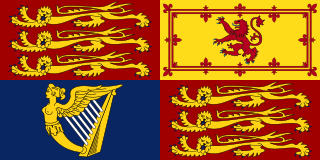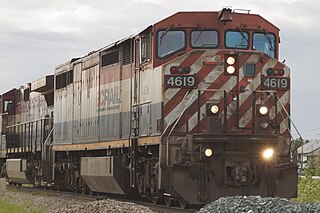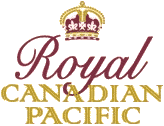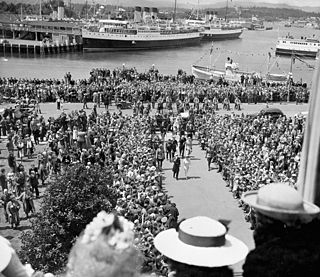
The Canadian Pacific Railway, also known simply as CPR or Canadian Pacific and formerly as CP Rail (1968–1996), was a Canadian Class I railway incorporated in 1881. The railway was owned by Canadian Pacific Railway Limited, which began operations as legal owner in a corporate restructuring in 2001.

Mary of Teck was Queen of the United Kingdom and the British Dominions, and Empress of India, from 6 May 1910 until 20 January 1936 as the wife of King-Emperor George V.

Princess of Wales is a courtesy title used since the 14th century by the wife of the heir apparent to the English and later British throne. The current title-holder is Catherine.

The Royal Standards of the United Kingdom presently refer to either of two similar flags used by King Charles III in his capacity as Sovereign of the United Kingdom, the Crown dependencies, and the British Overseas Territories. Two versions of the flag exist, one for use within Scotland and the other for use elsewhere.

BC Rail is a railway in the Canadian province of British Columbia.

The royal standards of Canada are a set of uniquely Canadian personal flags used by members of the Canadian royal family. They are used to denote the presence of the bearer within any car, ship, airplane, building, or area, within Canada or when representing Canada abroad. A royal standard for the present Canadian monarch, King Charles III, was unveiled on May 6, 2023, on the date of his coronation. There are five other personal royal standards, one each for the Prince of Wales, the Princess Royal, the Duke of York, and the Duke of Edinburgh, as well as one standard for use more generally to denote the presence of any member of the royal family who has not previously been provided with a specific personal standard. The flags are part of a larger collection of Canadian royal symbols.
Colonel-in-chief is a ceremonial position in a military regiment. It is in common use in several Commonwealth armies, where it is held by the regiment's patron, usually a member of the royal family.
A royal train is a set of railway carriages dedicated for the use of the monarch or other members of a royal family. Most monarchies with a railway system employ a set of royal carriages.

The Royal Hudsons are a series of semi-streamlined 4-6-4 "Hudson" type steam locomotives formerly owned and operated by the Canadian Pacific Railway (CPR) and built by Montreal Locomotive Works (MLW). The engines were built in 1937. In 1939, King George VI allowed the CPR to use the term after Royal Hudson number 2850 transported the royal train across Canada with no need of replacement. These locomotives were in service between 1937 and 1960. Four of them have been preserved. No. 2839 was used to power excursions for the Southern Railway Steam Program between 1979 and 1980. No. 2860 was used for excursion service in British Columbia between 1974 and 1999, then again between 2006 and 2010.

The Canadian Railway Museum, operating under the brand name Exporail in both official languages, is a rail transport museum in Saint-Constant, Quebec, Canada, on Montreal's south shore.

By the arrangements of the Canadian federation, the Canadian monarchy operates in Saskatchewan as the core of the province's Westminster-style parliamentary democracy. As such, the Crown within Saskatchewan's jurisdiction is referred to as the Crown in right of Saskatchewan, His Majesty in right of Saskatchewan, or His Majesty the King in right of Saskatchewan. The Constitution Act, 1867, however, leaves many royal duties in Saskatchewan specifically assigned to the sovereign's viceroy, the Lieutenant Governor of Saskatchewan, whose direct participation in governance is limited by the conventional stipulations of constitutional monarchy.

Royal tours of Australia by the British royal family have been taking place since 1867. Since then, there have been over fifty visits by a member of the Royal Family, though only six of those came before 1954. Elizabeth II is the only reigning monarch of Australia to have set foot on Australian soil; she first did so on 3 February 1954, when she was 27 years old. During her sixteen journeys, the Queen visited every Australian state and the two major territories.

The British Royal Train is used to convey senior members of the British royal family and associated staff of the Royal Household around the railway network of Great Britain. It is owned, maintained and operated by DB Cargo UK.

The Royal Canadian Pacific is a luxury excursion passenger train operated by Mount Stephen Properties, a wholly owned subsidiary of the Canadian Pacific Railway and later CPKC Railway. It made its first run on June 7, 2000, after the CPR received the royal designation for the service from Elizabeth II, Queen of Canada.

The Victorian Railways' (VR) Royal Trains operated to transport members of the Royal Family on their numerous tours of Australia on the Victorian rail network. The same carriages were also used for a number of vice-regal trains for the Governor-General of Australia and the Governor of Victoria. The last Royal Train ran in 1988.
In Canada, a number of sites and structures are named for royal individuals, whether a member of the past French royal family, British royal family, or present Canadian royal family thus reflecting the country's status as a constitutional monarchy under the Canadian Crown. Those who married into the royal family are indicated by an asterisk (*). Charles Edward Stuart was a pretender to the British throne.

Royal tours of Canada by the Canadian royal family have been taking place since 1786—when the future King William IV became the first member of the royal family to visit Canada—and continue into the 21st century, either as an official tour, a working tour, a vacation, or a period of military service by a member of the royal family. In 1939, King George VI became the first reigning monarch to tour the country.

Parkdale railway station or North Parkdale railway station as it was also known was a passenger train station in Toronto, Ontario, Canada. The station served the Parkdale village on the then-outskirts of Toronto. The station served trains on the Northern Railway of Canada and Credit Valley Railway, later the Canadian Pacific Railway, railways. It was situated at the intersection of Dufferin Street and Queen Street West. The train station was decommissioned in the 1970s.
Royal visits to New Zealand by members of the Royal Family have been taking place since 1869. The first member of the Royal Family to visit New Zealand was Prince Alfred, Duke of Edinburgh. Subsequently, there have been over 50 visits. The first reigning monarch of New Zealand to visit the country was Elizabeth II in 1953–54. In all, she visited New Zealand on 10 occasions, most recently in 2002.



















